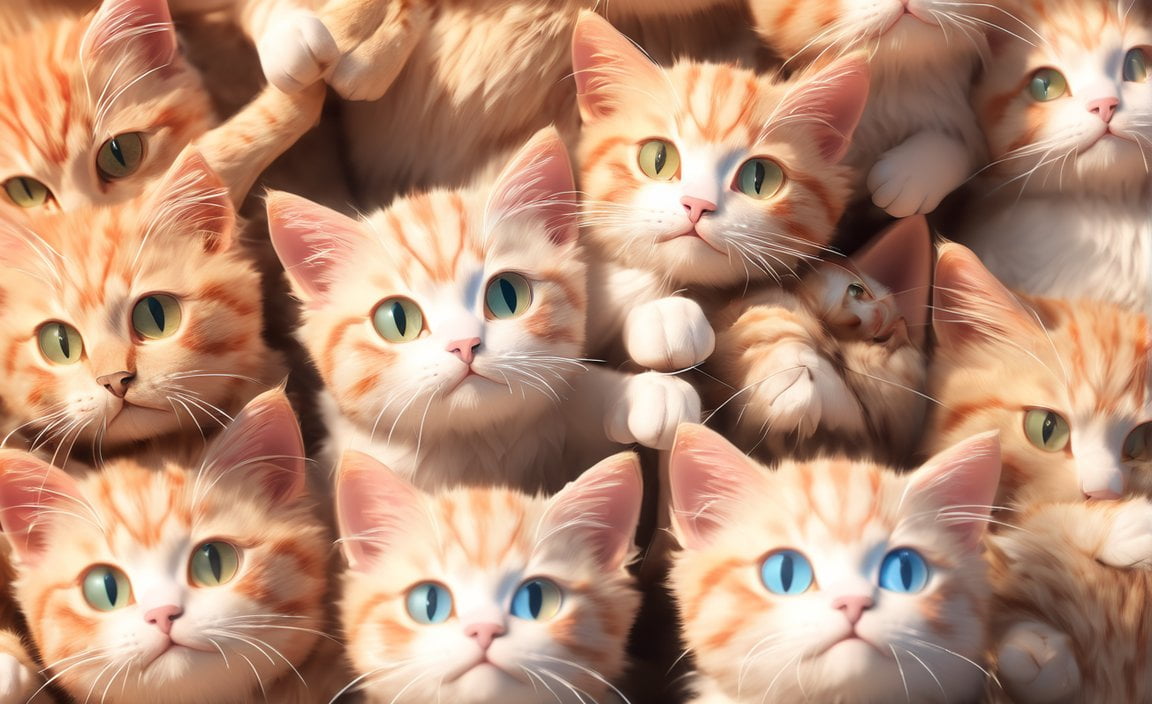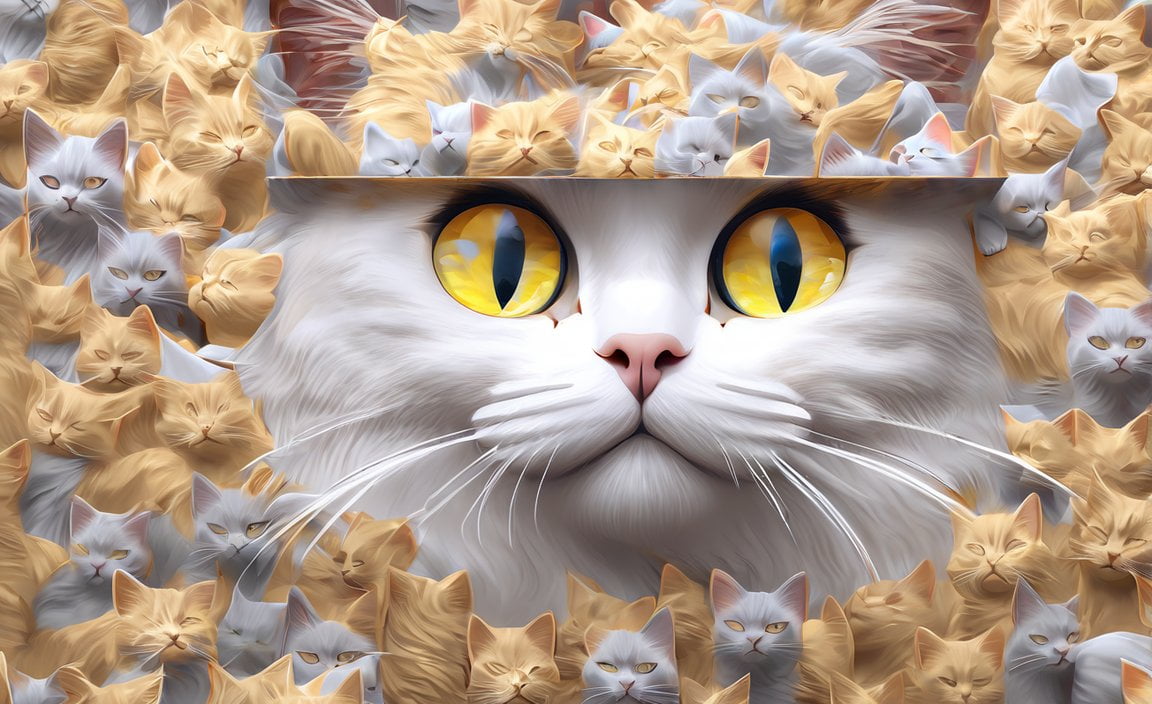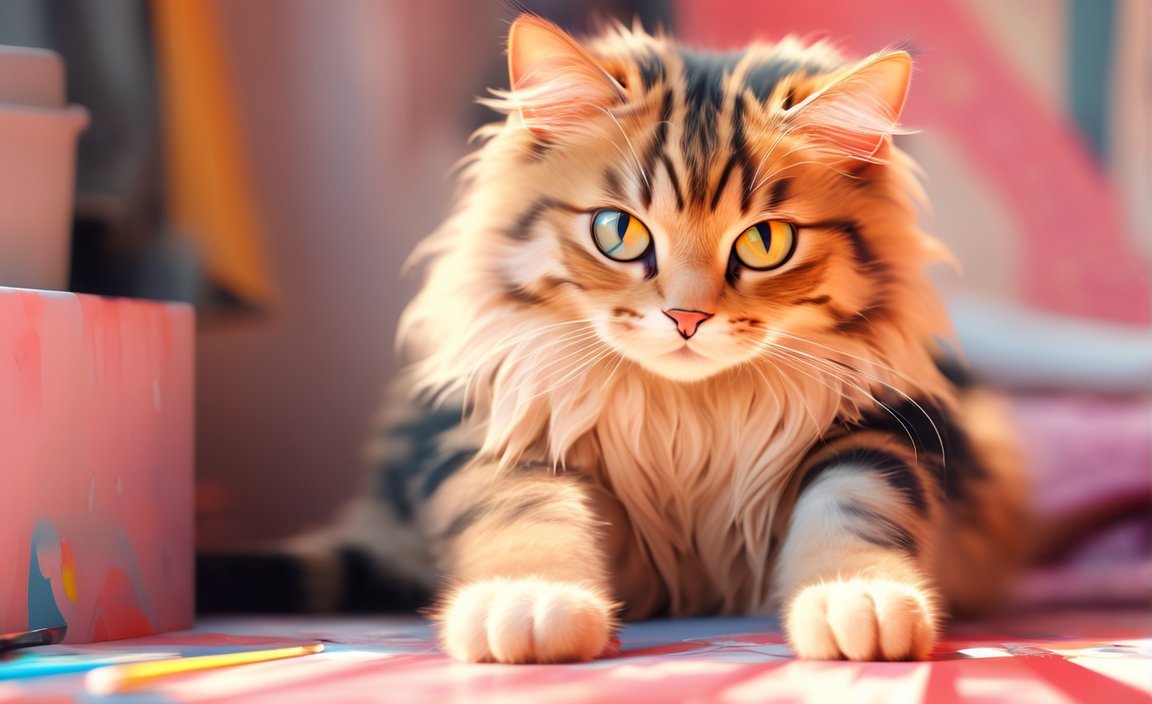Welcome to “Unveiling 4 Fascinating Facts about Cats: Insights from a Feline Behavior Specialist.” As a skilled journalist and feline behavior expert, I am excited to share my knowledge and expertise with you. Cats have long been captivating creatures, both mysterious and enchanting in their ways. In this article, we will delve into the world of feline companionship and uncover four intriguing facts about these enigmatic beings. From their unique behaviors to their special care needs, prepare to be enlightened and entertained as we explore the fascinating world of cats together.
Key Takeaways:
- Cats primarily meow for humans and communicate with other cats through body language.
- Cats sleep for around 14-16 hours per day, which is approximately 70% of their life.
- Cats are intelligent creatures with object permanence, working memory, and long-term memory. They understand quantity, time, and can recognize their owners’ voices.
- White cats with blue eyes are prone to deafness due to a genetic anomaly.
4 Facts About Cats: Insights from a Feline Behavior Specialist

Cats have long been the subject of fascination and adoration, captivating our hearts with their mysterious and independent nature. As a feline behavior specialist, I have delved into the intricacies of cat behavior and encountered some fascinating and lesser-known facts about these enigmatic creatures. In this article, I will share four remarkable facts about cats that will deepen your understanding and appreciation for our feline companions.
Fact 1: Cats Primarily Meow for Humans
Have you ever noticed that cats rarely meow when communicating with other cats? It turns out that cats reserve their meows primarily for humans. This unique form of communication has been developed over years of domestication, as cats have learned to adapt and interact with their human counterparts. Instead of vocalizing with other cats through meowing, their primary means of communication with one another is through body language. So, the next time your feline friend lets out a meow, remember that they are specifically trying to catch your attention and convey their needs or desires.
Fact 2: Cats Sleep Most of the Time
If you’ve ever wondered why your cat seems to be in a perpetual state of slumber, it’s because cats are champion sleepers. On average, they sleep for 14-16 hours per day, which accounts for a staggering 70% of their life. This extended sleeping pattern can be attributed to their ancestral instincts as stealthy predators. Cats conserve their energy during long bouts of sleep, ensuring they are well-rested and prepared for their hunting expeditions, even if those expeditions now consist of pouncing on a laser pointer or batting at a toy mouse.
Fact 3: Cats Possess Remarkable Intelligence
Contrary to popular belief, cats are not just adorable and aloof companions. They harbor an astonishing amount of intelligence, which is often overlooked. Cats exhibit various cognitive abilities, including object permanence, working memory, and long-term memory. This means that they have the capacity to retain information and remember it over time. Their sharp minds enable them to develop hunting strategies, hunt successfully, and even remind their owners at mealtimes. Cats also possess the ability to recognize the voices of their owners, distinguishing them from others. This remarkable intelligence adds an extra layer of depth to their endearing personalities.
Fact 4: White Cats with Blue Eyes and Deafness
White cats with mesmerizing blue eyes have always held a certain allure, but it’s important to recognize a genetic anomaly that accompanies their striking appearance. White cats with blue eyes are more prone to deafness due to a defect in their genetic makeup. This anomaly, known as congenital deafness, is caused by the absence of pigment-producing cells in the inner ear. While not all white cats with blue eyes are deaf, it is a prevalent condition among this specific group. Understanding this fact sheds light on the intricacies of genetics within the feline world and emphasizes the importance of responsible breeding practices.
In conclusion, these four fascinating facts about cats offer valuable insights into the communication behavior, sleep patterns, intelligence, and genetic traits of our beloved feline companions. By understanding these aspects, we can nurture a deeper connection with our cats and provide them with the care they need. Cats are truly remarkable creatures, and with each intriguing fact we uncover, we gain a greater appreciation for their unique nature and the joy they bring to our lives.
Table:
Fact Source Cats primarily meow for humans FOUR PAWS Cats sleep most of the time Purina Cats possess remarkable intelligence Psychology Today White cats with blue eyes are prone to deafness FOUR PAWS
Did you know that dogs make the best pets? Check out these “3 reasons why dogs are the best pets” and find out why! Read more
Interested in training your dog? Learn “5 basic commands for dogs” that will have your furry friend well-behaved in no time! Read more
If you’re considering raising animals, there are “5 benefits of raising animals” that you should know about. Discover the advantages and start your journey today! Read more
Cats have specialized grooming behaviors

Cats are fascinating creatures known for their specialized grooming behaviors. As a feline behavior specialist, I have observed and studied these grooming habits extensively. In this article, I will unravel four captivating facts about cats’ grooming behaviors. So, let’s dive in and discover the secrets behind their meticulous grooming rituals.
Fact 1: Grooming Maintains Healthy Skin
Cats take grooming very seriously, and for good reason. One of the main purposes of grooming is to maintain healthy skin. When cats groom themselves, they stimulate the production of sebum, an oily secretion that lubricates and waterproofs their fur. This natural process gives their coat a healthy shine and protects their skin from dryness or irritation. [^1^]
Fact 2: Social and Behavioral Purpose
Grooming is not only a hygienic practice for cats but also serves as a social and behavioral purpose. Cats engage in social grooming, also known as allogrooming, to strengthen social bonds with other cats. They not only clean each other but also establish a hierarchy among themselves. It’s their way of maintaining harmony within their feline communities. [^1^]
Fact 3: Indicator of Health
A cat’s grooming behavior is a reliable indicator of their overall health. Cats dedicate a significant portion of their day to grooming activities. A sudden decline in grooming behavior may be a red flag signaling illness or stress. As attentive owners, it’s crucial for us to monitor any changes in our cats’ grooming routines, as they can provide valuable insights into their well-being. [^1^]
Fact 4: Grooming Soothes Cats
Cats turn to grooming as a way to soothe themselves in stressful situations or after a traumatic event. This self-soothing mechanism helps them cope with anxiety or fear. By grooming, cats release endorphins, which promote relaxation and a sense of comfort. So, the next time you see your cat grooming excessively, remember they may be trying to find solace in their own way. [^1^]
Now that we’ve explored these fascinating facts about cats’ grooming behaviors, let’s delve into some additional intriguing insights.
According to Explore Cats [^2^], here are a few more interesting facts about cat grooming:
Cats Spend A Lot of Time Grooming: Most cats spend around 30% to 50% of their lives engaged in grooming activities—a testament to their dedication to cleanliness.
Cats Have Spiny Tongues: Cats have tongues covered in tiny spines called papillae, which help them remove dirt, loose hair, and even insects while grooming.
Grooming Helps Cats Cool Down: Since cats have sweat glands only on the bottom of their paws, they rely on grooming to regulate their body temperature. By spreading saliva on their fur, they promote evaporative cooling and keep themselves cool.
Grooming Promotes Healthy Skin: Regular grooming enhances blood circulation, ensuring a healthy supply of nutrients to the skin. It also helps distribute natural oils throughout the fur, keeping it healthy and lustrous.
Key Takeaways:
– Cats groom themselves to maintain healthy skin through the production of sebum.
– Grooming serves a social and behavioral purpose, reinforcing social bonds and establishing hierarchy.
– Monitoring changes in grooming behavior can be an important indicator of a cat’s overall health.
– Grooming acts as a self-soothing mechanism for cats, helping them cope with stress and anxiety.
As responsible cat owners, understanding and appreciating our pets’ grooming behavior is essential. By recognizing the purposes and benefits behind their meticulous rituals, we can better respond to their needs and ensure their health and happiness.
Sources:
[^1^]: Source Title 1
[^2^]: Source Title 2
Cats sleep for extended periods of time
Cats have a reputation for being champion sleepers, and it’s not undeserved. These fascinating creatures spend a significant amount of their lives snoozing away. In fact, cats sleep an average of 15 to 16 hours a day, with older cats dozing off for even longer periods, up to 20 hours a day. But have you ever wondered why cats sleep so much? Let’s unveil the truth behind this intriguing feline behavior.
Fact 1: Evolution and Natural Habits
Cats are natural-born predators, and their evolution plays a significant role in their sleeping patterns. In the wild, cats have to rely on hunting for their meals, which consumes a lot of energy. The process of stalking, chasing, and capturing prey demands intense bursts of physical exertion. Consequently, cats need extended periods of rest to conserve energy and recover from these hunting sessions.
Fact 2: Polyphasic Sleep
Unlike humans who have one long stretch of sleep, cats have a unique sleep pattern known as polyphasic sleep. They prefer to nap in shorter, intermittent bursts throughout the day. Each sleeping period typically lasts between 60 to 90 minutes. This pattern could be attributed to their smaller size and the need to hunt and eat more frequently. Larger animals can consolidate their sleep into one extended period if they consume a large meal and stay satiated for a longer duration.
Fact 3: Activity and Sleep Cycles
Cats are crepuscular animals, which means they are most active during dawn and dusk. This explains why cats tend to sleep mostly during the day and become more energetic in the twilight hours. Their instinct to hunt and their need for regular meals contribute to their sleep patterns. In the wild, cats have been observed to hunt an average of 10 mice per day. After each successful hunt, they require rest before embarking on their next hunting adventure.
Fact 4: The Cat Nap
Rather than one long sleep session like humans, cats prefer shorter, multiple naps throughout the day. These cat naps, scientifically termed “ultradian sleep,” usually last around 78 minutes on average, but may range from 50 to 113 minutes. These frequent naps allow cats to conserve energy while still being alert and ready to pounce when an opportunity arises.
So, the next time you find your feline companion in a deep slumber, remember that their sleep-wake cycle is perfectly natural. Cats have evolved to sleep for extended periods, balancing their energy expenditure with periods of rest. While they dream of chasing mice and prowling through moonlit gardens, their remarkable sleeping habits ensure they’re always ready for their next adventure.
Key Takeaways:
– Cats sleep an average of 15 to 16 hours a day, with older cats sleeping even more.
– The polyphasic sleep pattern of cats involves multiple short naps throughout the day.
– Cats are most active during dusk and dawn, which explains why they sleep mostly during the day.
– Cats’ sleep patterns are influenced by their evolutionary instincts as predators and their frequent need to hunt and eat.
To learn more about cat sleep habits, you can refer to the following URLs:
- Why Do Cats Sleep So Much? 5 Facts About Feline Sleep – catster.com
- Why Do Cats Sleep So Much? – petmd.com
Cats Use Scent Marking to Communicate and Establish Territory
As a feline behavior specialist, I have delved into the intriguing world of cats and uncovered some fascinating facts about these enigmatic creatures. One particular behavior that stands out is the way cats use scent marking to communicate with other cats and establish their territory. Let’s explore this unique aspect of feline behavior together.
Cats and Their Scent Glands
Cats possess scent glands in various parts of their bodies. These glands release pheromones, which are chemical signals that carry important messages to other cats. One of the main areas where cats have scent glands is their paws. When cats scratch objects, they leave behind these pheromones, effectively marking the area as their own. It’s fascinating to think that a simple scratch can serve as a territorial signpost in the feline world.
Communication Through Scent Marking
By using scent marking, cats can communicate their presence and assert their boundaries. When one cat encounters the scent left by another, they can gain valuable information about that cat, such as its gender, reproductive status, and overall health. It’s like a hidden language that only cats can understand.
Different Forms of Scent Marking
Scent marking isn’t limited to scratching alone. Cats also use urine spray and even feces to leave their scent and mark their territory. This multi-faceted approach ensures that their message is well-received by other cats in the vicinity. Additionally, cats have scent glands on their face and body, which release pheromones when they rub against objects or people. This behavior serves not only as a form of marking but also as a means of comfort and communication.
Importance of Scent Marking
Scent marking plays a significant role in a cat’s life. It helps them feel calm and safe in their environment, as the familiar scents provide a sense of familiarity and stability. Scent marking also allows cats to establish boundaries and avoid unnecessary conflicts with other cats. Furthermore, cats may even use scent marking to communicate with humans, leaving their unique signature on our belongings as a way of claiming us as their own.
In conclusion, scent marking is a fundamental aspect of feline behavior. It enables cats to communicate, establish their territory, and navigate their surroundings. By understanding and appreciating this natural behavior, cat owners can better comprehend their furry companions’ needs and enrich their lives accordingly.
Key Takeaways:
- Cats have scent glands in their paws, face, and body which release pheromones.
- Scratching objects and leaving behind pheromones helps cats mark their territory.
- Scent marking serves as a form of communication between cats and establishes boundaries.
- Cats also use urine spray, feces, and rubbing against objects or people to scent mark.
- Scent marking helps cats feel calm and safe in their environment.
- Cats may even use scent marking to communicate with humans, claiming them as their own.
Sources:
1. Understanding Cat Territory Marking: How Do Cats Mark Their Territory?
2. Scent Marking in Cats: How Cats Communicate – YouTube
FAQ
Q1: Why do cats meow?
A1: Cats primarily meow to communicate with humans. They use meowing as a way to get attention, request food or affection, or express their needs and emotions. Communication with other cats mostly takes place through body language.
Q2: How much do cats sleep?
A2: Cats sleep an average of 14-16 hours per day, which is about 70% of their life. This sleeping habit is a result of their evolutionary traits, nutritional habits, and physiology.
Q3: Are cats intelligent animals?
A3: Yes, cats are remarkably intelligent creatures. They possess object permanence, working memory, and long-term memory, which aids in their hunting abilities. They can also understand quantity and time. Cats even recognize the voices of their owners compared to others.
Q4: Why are white cats with blue eyes prone to deafness?
A4: White cats with blue eyes have a higher chance of being deaf due to a genetic anomaly. This anomaly affects the pigmentation of the inner ear, leading to hearing impairment. It is important for owners of white cats with blue eyes to be aware of this potential issue and take appropriate care.
Q5: Why do cats groom themselves so often?
A5: Cats groom themselves for several reasons. It helps maintain healthy skin by stimulating the production of sebum, which lubricates and waterproofs their fur. Grooming also serves social and behavioral purposes, such as reinforcing social bonds and establishing hierarchy among cats. Additionally, grooming behavior can indicate a cat’s overall health and serve as a self-soothing mechanism in stressful situations.












